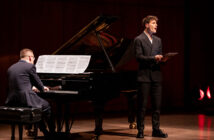
This page is also available in / Cette page est également disponible en:
Français (French)
Orchestre symphonique de Longueuil
Alexandre Da Costa, violin and conductor; Bruno Pelletier and La Bronze, guest soloists
Théâtre Plaza de Montréal
March 12, 2021
On March 12, the OSDL put its Stradivarius BaROCK symphonique concert online, with violinist Alexandre Da Costa as conductor and soloist. Unlike most of the virtual concerts we have had the opportunity to watch, this wasn’t just about recording an event from the parterre or the balcony.
Differing elements of this video gave us another experience, much more immersive, that went well beyond the performance of the pieces. The OSDL brought in radio host Sonia Benezra to conduct interviews in a relaxed and friendly style; first and most frequently with Da Costa, and then, over the course of the evening, with two guest artists. the famous singer Bruno Pelletier, who distinguished himself in Caccini’s Ave Maria, and the writer-composer-performer La Bronze. Thus the concert alternated between brief exchanges, more in-depth conversations and musical performances. The OSDL has found a formula that is more elaborate and better adapted to the present context than a simple filmed concert.
Unusual Program
Have you ever heard Vivaldi, Bach and Pachelbel in rock versions, to the beat of the drums? For those who regularly browse social media and YouTube, the answer might be yes. There is no shortage of videos of this kind, as the YouTubers Mozart Heroes (388K subscribers) and Tempus Quartet (41K subscribers) attest. The novelty here lay rather in the fact of a well-established Quebec orchestra opting for this classical-pop mix. The OSDL remained cautious, however. There were extended solos or interludes of drumming, just a simple “rock” touch, hardly noticeable most of the time. Ditto jazz sounds. In other words, the arrangements, most by double bassist Éric Lagacé, remained fairly faithful to the originals. Rock enthusiasts found their needs attended to in a highly percussive arrangement of Pachelbel’s Canon.
Whether in rock or classic mode, Da Costa was fully engaged as conductor and soloist. The intensity was there, but sometimes he lacked inner emotion. In Bach’s famous Chaconne, for example, it would have been good to hear more nuance and a more intimate approach to the music, at a slower tempo. Other highlights included the performance by La Bronze of words and music based on the St. Matthew Passion. This went straight to the heart. We felt a real osmosis between classical and pop, a close interweaving of tradition and artistic innovation which, we hope, will persuade other pop musicians to consider stepping into the realm of classical music.
This page is also available in / Cette page est également disponible en:
Français (French)















